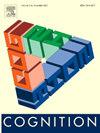Kinematics in context: Predicting other’s action intentions entails the perception of affordances
IF 2.8
1区 心理学
Q1 PSYCHOLOGY, EXPERIMENTAL
引用次数: 0
Abstract
Intention prediction is essential for successful social interaction, but traditional research focusing solely on movement kinematics often overlooks the array of action possibilities in natural settings. This study employs a mixed-methods approach to explore intention prediction, analysing free-text responses from participants who watched videos of an actor reaching for a cup, bottle, or spoon, each with a distinct intention. Each video included varied environmental contexts to suggest specific intentions (e.g., full cups for drinking, empty cups for clearing) or presented ambiguous contexts (e.g., half-full cups). We found that participants’ intention predictions depended on the variety of action possibilities presented by both kinematics and context. Participants tended to identify the primary action possibility of the grasped item as the intended action when both kinematics and context supported its feasibility. Predictions diversified when kinematics or context suggested that the object’s primary action was less likely. Our findings suggest that while intention predictions can sometimes be inaccurate, they align with the (most functional) action possibilities (i.e., affordances) indicated by the actor’s movements within a given context.
情境中的运动学:预测他人的行为意图需要对可视性的感知
意图预测对于成功的社会互动至关重要,但传统的研究只关注运动运动学,往往忽视了自然环境中一系列的行动可能性。这项研究采用混合方法来探索意图预测,分析参与者观看演员伸手拿杯子、瓶子或勺子的视频时的自由文本反应,每个视频都有不同的意图。每个视频都包含不同的环境背景来暗示特定的意图(例如,满的杯子用来喝,空的杯子用来清理)或呈现模糊的背景(例如,半满的杯子)。我们发现参与者的意图预测依赖于运动学和情境所呈现的各种行动可能性。当运动学和情境都支持其可行性时,参与者倾向于将抓取项目的主要动作可能性识别为预期动作。当运动学或环境表明物体的主要动作不太可能时,预测就会多样化。我们的研究结果表明,虽然意图预测有时可能是不准确的,但它们与(最实用的)行动可能性(即,在给定背景下,演员的动作所指示的可视性)是一致的。
本文章由计算机程序翻译,如有差异,请以英文原文为准。
求助全文
约1分钟内获得全文
求助全文
来源期刊

Cognition
PSYCHOLOGY, EXPERIMENTAL-
CiteScore
6.40
自引率
5.90%
发文量
283
期刊介绍:
Cognition is an international journal that publishes theoretical and experimental papers on the study of the mind. It covers a wide variety of subjects concerning all the different aspects of cognition, ranging from biological and experimental studies to formal analysis. Contributions from the fields of psychology, neuroscience, linguistics, computer science, mathematics, ethology and philosophy are welcome in this journal provided that they have some bearing on the functioning of the mind. In addition, the journal serves as a forum for discussion of social and political aspects of cognitive science.
 求助内容:
求助内容: 应助结果提醒方式:
应助结果提醒方式:


